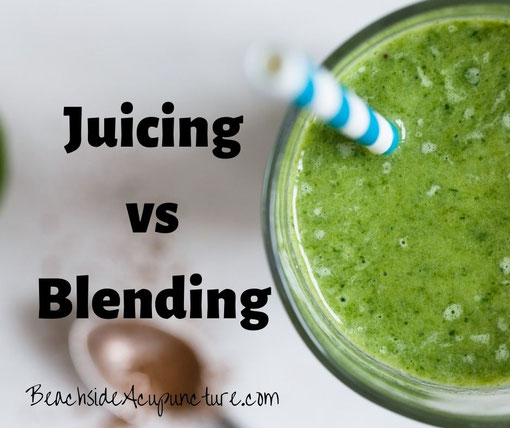
This post contains affiliate links, meaning Beachside Community Acupuncture PLLC may receive a small commission for purchases made through certain links at no additional cost to you. (In other words, you support us in a small way when you buy the products that we highly recommend and would use ourselves!) Click here to view our full disclosure policy.
Whether or not your diet already contains a lot of fruits and vegetables, juicing and blending offer an opportunity to consume even more produce and therefore absorb even more nutrients, often in an easier-to-digest form. Both involve mashing produce until it's liquid, but after that, their similarities end and differences begin. There are pros and cons to each method of drinking your vegetables, and you may end up preferring one to another (or opt to do both!).
Juicing
Juicing produce is akin to wringing water out of a towel: The goal is to get every last drop out and leave dry remnants. Because of this, you're left with a pure liquid that looks almost exactly like any bottled juice that you would buy at a grocery store. Fresh juice will always contain more nutrients, though, and will also be free from preservatives, coloring, and any other additives. Juicers used to be loud and difficult to clean, but our favorite juicer is relatively quiet and very user-friendly.
Pros:
- Most easily digestible nutrients: Digestion takes time and energy, but when nutrients are in a purely liquid form, there are no pieces for the stomach to chemically break down.
- Ability to consume many more vegetables: Every vegetable has a different amount of liquid content - think of a carrot's crunchiness versus a cucumber's softer texture - but either way, the amount of juice that comes from the vegetable is fairly small, meaning to fill a glass of juice, you will need a greater number of vegetables than you would usually eat at once.
Cons:
- Ability to consume many more fruits: While this was a pro in the vegetable category, fruits contain natural sugar. They can add a bit of sweetness and their own unique nutrients to a juice, but drinking tons of straight fruit juice will add a good amount of sugar to your diet. (Natural sugar can still cause issues with blood glucose levels and insulin spikes.) Just as it's easier to consume ten stalks of celery when they've been juiced, you'd be surprised at how many apples you can down in one glass of fresh juice!
- Absence of fiber: Juice is a pure liquid because the fibrous part of produce is left as waste. (Of course, we recommend using these leftovers in a productive way, such as in cooking or compost.) This makes the juice's nutrients readily absorbed, but people who do not eat enough vegetables and whole grains usually need more fiber in their diets. Fiber can improve some types of constipation and help maintain the intestinal lining, so if you know you're not getting enough of it, blending might be a better option.
Blending
Chances are that while you may never have used a juicer before, you've probably used a blender. Blending produce to make a smoothie is just like blending anything else: Throw everything in and turn it on! Blenders will always be much easier to clean than juicers because of this - once you pour out your smoothie, there's not much else left - but they still have many differences by brand, model, etc. There are plenty of great blenders out there, but our favorite is still the Vitamix.
Pros:
- Abundance of fiber: If you know you need more fiber in your diet, blending produce breaks it down to small, easy-to-digest pieces...but leaves all of its fibrous content.
- Ability to add additional foods and supplements: Smoothies can contain fruits and vegetables, but they're also great vehicles for nuts, seeds, powders, drops, supplements, and anything else that you might not otherwise take on its own. Blending mixes all of these substances together to the point that you can't distinguish one from the other, and drinking a single smoothie is often much less of a hassle than taking each of its components individually.
cons:
- Possible difficulty drinking: There is a bit of art to making the perfect smoothie, and there's no denying that it is much easier to knock back a glass of juice than to gulp down a thick smoothie. That being said, you can experiment with adding more water, milk, coconut water, etc. to your smoothie until you find the amount that balances the more viscous ingredients that you're using.
- Often cold temperatures: Frozen produce and ice are often added to smoothies to thicken them and/or increase their palatability. However, Traditional Chinese Medicine (TCM) believes that the major digestive organ prefers to be warm and therefore recommends limiting cold foods and beverages. When blending smoothies at home, set out all of your ingredients for a bit to bring them closer to room temperature, and avoid adding ice.

Chinese Diet Therapy
If you've been to our clinic, you might also be thinking, "TCM also says to limit raw vegetables, so I shouldn't be juicing OR blending." You are correct in that Chinese diet therapy believes lightly cooking vegetables makes them easier to digest, but we like combining naturopathy and TCM, and therefore think that additional fruits and vegetables consumed as a juice or smoothie can be helpful for people who find it difficult to add them to their diets otherwise.
That being said, if you tend to run very cold, are very fatigued, or have digestive issues like bloating and loose stools, you probably should stick to warm, cooked vegetables only. (If you notice that you start to develop these symptoms as your juicing or blending, take a break!) We also advise against drinking your vegetables first thing in the morning as gently waking the digestive system with warm water and warm food is less of a shock. The key is to be mindful of your body and how it changes with your diet and lifestyle adjustments, in relation to the seasons, etc., and if you need more help with that, you're more than welcome to bring it up at your next appointment.

Kathleen Ketola is a Licensed Acupuncturist and the owner of Beachside Community Acupuncture. She loves providing affordable acupuncture to the residents of McKinney, Texas, and surrounding cities like Prosper, Frisco, and Plano, but she also enjoys educating the general public on how acupuncture and Traditional Chinese Medicine (TCM) can treat everything from pain to infertility to stress and beyond. Click "Book Now" at the top of this page to book an appointment or feel free to contact her at (214) 417-2260.








